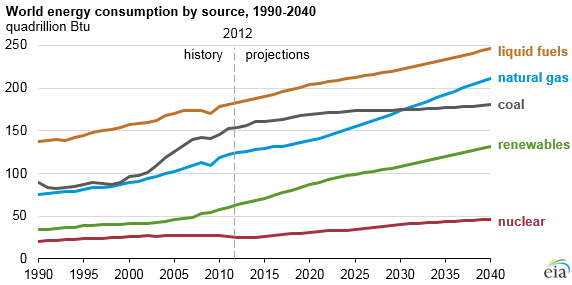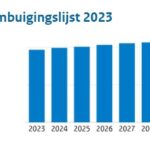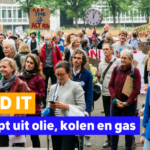
In het rapport ‘Visie 2030’ van Urgenda kunnen we lezen:
Nederland kan zijn energievoorziening binnen twintig jaar volledig verduurzamen. In het rapport Nederland 100% duurzame energie in 2030. Het kan als je het wilt, zet Urgenda uiteen hoe het 5 keer anders kan op het gebied van wonen, vervoer, voedsel, produceren en energie opwekken. Een scenario met 100% duurzame energie blijkt goedkoper en schoner dan doorgaan op de oude voet, schept 150.000 nieuwe banen, biedt energiezekerheid en is een motor voor innovatie. Dit rapport is gepubliceerd in maart 2014.
Volgens de gebruikelijke propaganda was de klimaattop in Parijs een overweldigend ‘succes’. Vele landen in de wereld hebben de indruk weten te wekken dat zij zich zullen inzetten voor de vermindering van het aandeel van fossiele energie in hun ‘energy mix’. Recentelijk verscheen echter een nieuwe klimaatstudie van de ‘U.S. Energy Information Administration’ (EIA) tot het jaar 2040, waarin nauwelijks iets is terug te vinden van al deze mooie beloften. Volgens de projecties van het EIA zal het wereldwijde aandeel van duurzame energie weliswaar gestaag toenemen, maar toch vèr achterblijven bij dat van fossiele energie.
Ik citeer:
EIA projects 48% increase in world energy consumption by 2040 graph of world energy consumption by source, as explained in the article text
Source: U.S. Energy Information Administration, International Energy Outlook 2016
The U.S. Energy Information Administration’s recently released International Energy Outlook 2016 (IEO2016) projects that world energy consumption will grow by 48% between 2012 and 2040. Most of this growth will come from countries that are not in the Organization for Economic Cooperation and Development (OECD), including countries where demand is driven by strong economic growth, particularly in Asia. Non-OECD Asia, including China and India, accounts for more than half of the world’s total increase in energy consumption over the projection period.
Concerns about energy security, effects of fossil fuel emissions on the environment, and sustained, long-term high world oil prices support expanded use of nonfossil renewable energy sources and nuclear power. Renewables and nuclear power are the world’s fastest-growing energy sources over the projection period. Renewable energy increases by an average 2.6% per year through 2040; nuclear power increases by 2.3% per year.
Even though nonfossil fuels are expected to grow faster than fossil fuels (petroleum and other liquid fuels, natural gas, and coal), fossil fuels still account for more than three-quarters of world energy consumption through 2040. Natural gas, which has a lower carbon intensity than coal and petroleum, is the fastest-growing fossil fuel in the outlook, with global natural gas consumption increasing by 1.9% per year. Rising supplies of tight gas, shale gas, and coalbed methane contribute to the increasing consumption of natural gas.
Although liquid fuels—mostly petroleum-based—remain the largest energy source, the liquids share of world marketed energy consumption is projected to fall from 33% in 2012 to 30% in 2040. As oil prices rise in the long term, many energy users adopt more energy-efficient technologies and switch away from liquid fuels when feasible.
Inderdaad wordt veelal aangenomen dat de olieprijzen op de lange termijn zullen stijgen. Maar dat zou best eens héél lang kunnen duren. In ieder geval heerst hierover thans onzekerheid.
Coal is the world’s slowest-growing energy source, rising by only 0.6% per year through 2040. Throughout the projection period, the top three coal-consuming countries are China, the United States, and India, which together account for more than 70% of world coal consumption. China alone currently accounts for almost half of the world’s total coal consumption, but a slowing economy and plans to implement policies to address air pollution and reduce carbon dioxide emissions mean that coal use in China will begin to decline in the later years of the projection period. Coal use in India continues to rise and surpasses U.S. coal consumption after 2030.
Much of the analysis conducted for the IEO2016 was done before the release of the U.S. Environmental Protection Agency’s final Clean Power Plan (CPP). For this reason, the IEO2016 Reference case does not include the potential effects of the CPP regulations in the United States, analysis that shows the potential for significant reductions in U.S. coal consumption and increases in U.S. renewable consumption compared with the Reference case projection. …
Lees verder hier.
De EIA verzuimde hierbij te vermelden dat het Amerikaanse hooggerechtshof voorlopig een stokje heeft gestoken voor de plannen van het ‘Environment Protection Agency’ (EPA) om de CO2–uitstoot van kolencentrales aan banden te leggen – zulks in reactie op een klacht van vele staten, organisaties en bedrijven, dat het EPA hiermee zijn bevoegdheden overschreed. De regering Obama was hier niet blij mee en sprak het vertrouwen uit dat het hooggerechtshof in een later stadium van de rechtsgang alsnog het groene licht zal geven.
Hoe het ook zij, het gaat hier om een principiële, politiek uiterst controversiële kwestie, waarbij niet alleen tientallen miljarden op het spel staan, maar ook de banen van tienduizenden werknemers in de kolenindustrie.
Zie hier.
Voor mijn eerdere bijdragen over klimaat en aanverwante zaken zie hier, hier, hier, hier en hier.






Koffiedik. Als gerobotiseerde winning van methaan hydraten op gang komt dan kan het fossiele brandstoffen tijdperk zo met een paar eeuwen worden verlengd.
Immers: innovatie schept de resources.
Menigeen schetst een afkeurend beeld van fossiele brandstoffen door machines als onze nieuwe slaven te kenschetsen en door de eindigheid te benadrukken.
Dat is vreemd , hadden we kolen en olie dan in de grond moeten laten? Geen wetenschap, technologie? En hadden onze voorouders geen bomen mogen kappen, waar ze onder meer oorlogsschepen mee bouwden? Moeten we ijzerbereiding veroordelen?
Ik kies voor innovatie. De toekomst is niet te voorspellen maar dat was altijd al zo.
Aardige link: http://thetyee.ca/Opinion/2011/05/05/EnergySlaves/
Technisch gesproken is 100% duurzaam nu al mogelijk. Of het toegepast wordt, is in principe niets meer of minder dan een economische vraag. In principe zal die energievoorziening gekozen worden, die de laagste kostprijs heeft. En dat is vooralsnog absoluut geen duurzame energie. D.m.v. kunstgrepen proberen overheden duurzame energie aantrekkelijk te maken. In principe is dat pure concurrentievervalsing. Kijk naar de miljarden die in NL verspild worden. Zolang onze regering en Tweede Kamer kan dat doorgaan. Alleen de consument gaat het niet pikken. Waaro zou je 5x zoveel voor energie moeten betalen dan nodig is? En als er nu nog duidelijk aanwijsbare voordelen zouden zijn, vaak genoemd CO2, maar dat klopt niet, dan zou er nog een rationelle zijn. Die ontbreekt te enen male. Slechts dwazen kiezen dus voor duurzaam, zeker als het toch je eigen geld niet is.
Pieter: Duurzaam of niet, uiteindelijk slechts de technische vooruitgang zal primair de energiemix van de toekomst bepalen. De duurzame afvallers in de energiemix zijn nu al zichtbaar, omdat de technologie op het eind van zijn ontwikkeling is, zoals bij windturbines. De economische bepalende factoren worden thans door de politiek (negatief) beinvloed, zoals de olieprijs, overheidssubsidies voor laag energetische (=duurzame) energiebronnen.
Technisch gesproken?
“Duurzaam” en “hernieuwbaar” eist een vorm van technisch rendabele opslag en uiteraard voldoende materialen.
Niemand waagt zich aan onderbouwde prognoses in deze.
Terecht, er zijn geen aanwijzingen dat er de komende decennia een doorbraak is te verwachten.
Over de grafiek: 1 quadrillion Btu = 293 TWh
@Pieter
[Technisch gesproken is 100% duurzaam nu al mogelijk]
Hangt af van de definitie van duurzaamheid.
Als we subiet overschakelen op zon- en windenergie zoals deze lieden bepleiten
http://gofossilfree.org/nl/
dan moeten we jaarlijks een miljoen Nederlanders begraven tot de populatiedichtheid van het jaar 1800 is bereikt.
Nemen we het menselijk welzijn als maatstaf, dan is fossiel stoken de enige duurzame optie terwijl we werken aan nucleaire technologie.
@Pieter
[technisch gesproken]
Als we subiet overschakelen op zon- en winenergie dan moeten we jaarlijks een miljoen mensen begraven totdat de bevolkingsgrootte van 1800 is bereikt.
Of dit duurzaam te noemen is?
Met het menselijk welzijn voor ogen is duurzaamheid voorlopig fossiel stoken.
@Pieter Technisch zou het dan wel kunnen, maar dan wel gedurende een korte periode voordat we vervallen tot het maatschappelijk niveau van 250 jaar geleden waarbij boeren met paarden net de voedselbehoefte van de steden konden dekken. Urgenda heeft geen idee waar ze het over heeft en is volstrekt onverantwoord bezig met het verspreiden van niet alleen onzin over klimaatrampen, maar ook over de haalbaarheid van haar plannen in duurzame zin. Het wensdenken van Urgenda legt pijnlijk het verschil bloot tussen hernieuwbaar en duurzaam. Het wordt tijd dat de media hun aandacht richten op dit cruciale verschil.
Wij leven in een geinige maatschappij.
Weilanden vol paarden. Niet voor de PK’s maar voor de lol. Alleen in de sport(school) werken mensen zich nog in het zweet. En houtvuurtjes zijn eveneens nog slechts een recreatief gebeuren.
Deze warhoofden willen het kind met het badwater weggooien:
http://gofossilfree.org/nl/
Wij leven in een geinige maatschappij.
Weilanden vol paarden. Niet voor de PK’s maar voor de lol. Alleen in de sport(school) werken mensen zich nog in het zweet. En houtvuurtjes zijn eveneens nog slechts een recreatief gebeuren.
Wat is duurzaam?
Een zonnepaneel in China produceren wat omgerekend van grondstoffendelving tot afvoer (nogal vervuilend) 2600 kwh verbruikt en in de levensduur 2200 kwh teruglevert (1), onderwijl voor honderden euro’s per ton CO2-certificaten producerend waarmee de bruinkoolboer voor nauwelijks 5 euro de wereld nog een beetje extra kan vervuilen?
Grosso modo is het directe gebruik van (de uiteraard ook geheel natuurlijke) kolen in de hypermoderne, schone centrales in Nederland in die zin nog het beste wapen tegen zowel armoede als de temperatuur veraangenaming van een fractie van een graad.
(1) https://collapseofindustrialcivilization.files.wordpress.com/2016/05/ferroni-y-hopkirk-2016-energy-return-on-energy-invested-eroei-for-photo.pdf
Dank voor deze link. Zeer goed artikel.
EREOI < 1 voor zonnepanelen , de opslag niet eens meegerekend.
Gisteren was de NOS-nieuwsienst vergeten te vertellen over de sluiting van de Duitse kerncentrales door Mutti Merkel, terwijl de NOS de bruinkool-dagbouw blokkade door GreenPeace/ Milieu Defensie bekommentarieerden als de schuld van de trage omschakeling naar “duurzaam”.
Interessant was het noemen van de noodzaak van energie opslag. Omdat die niet bestaat is kolen nodig. Een paar jaar geleden was dit nog niet tot een breed publiek doorgedrongen.
de kreet ‘ fossiele energie dominant ‘ veronderstelt, dat er nog een andere vorm van energie is dan die van onze zon. ( indirect & direct , respectievelijk fossiele bronnen en wind/ zonne energie ) ) Behalve kernenergie bestaat die niet. De transitie zorgt er alleen maar voor dat de voorraden sneller worden opgemaakt, dan zonder transitie.
Over Urgenda zou ik me geen drukte maken. Die schieten in haar eigen voet door de aanhangers te verbieden nog te vliegen of auto rijden.
http://lesswatts.nl/lesswatts.nl/alfas-kun-je-alles-wijsmaken/
Ben benieuwd. Nu staat PV record al op 2,62 eurocent per Kwh, een half jaar gelden was dat nog 5,84. De prijzen dalen dus best wel hard.
Kun je dan in 2040 nog rendabel kolen uit de grond halen, over de aarde zeulen, opstoken en omzetten in electriciteit?
http://www.trouw.nl/tr/nl/5151/Vincent-wil-zon/article/detail/4293920/2016/05/03/Zonnestroom-in-een-jaar-helft-goedkoper-nog-slechts-2-6-cent-per-kWh.dhtml
Zonder opslag van “duurzaam” zal men wel moeten (tenzij men accepteert dat alleen bij zon en wind geproduceerd en geconsumeerd kan worden).
Wat doet een kg stearine of parafine tegenwoordig?
Dat wil niet zeggen dat zonnenpaneel in zonnige derde wereld landen geen grote rol zou kunnen spelen bij de productie van drinkwater en koeling in werkruimten.